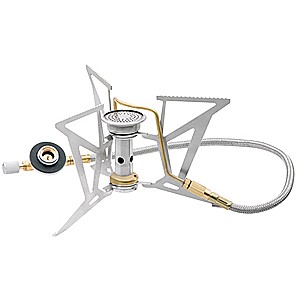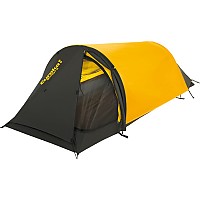Edelrid Opilio

I have done a fairly well controlled test and comparison of this stove in the kitchen and have used it in the field during a recent five-day backpacking trip.
In the field the stove works fairly well: it is stable and the pot supports are wide enough for a 2 litre; the pot supports also meet at the burner close enough for a cup; the control knob is flush with the canister and pivots on the hose axis, which makes upending for the dregs of gas very easy and would be beneficial in winter temperatures; the hose is loosely braided steel and is therefore more flexible, which is good in confined spaces.
But: it is painfully slow to boil (see below) and has a much too narrow flame spread for two-person pots or frying pans; the steel braided hose is not as durable as those found on Primus remote stoves; the female threads do not couple as quickly as Primus' ones with the canisters.
In the kitchen, with numerous fresh canisters and digital scales, the stove took TWICE as long as the Primus Gravity II EF (LP canister) and used the SAME amount of gas. In fact with a larger 2.5 litre pot, the Opilio could hardly manage a rolling boil - it is just too weak a flame. I would only want to use it with a narrow-based pot set like the Optimus Terra (which taper at the bottom), as it is pretty pathetic to see with anything approaching a larger base.
Bear in mind that the Primus Gravity II (LP canister-only) stove is not even as efficient as the good top burner LP stoves like the Optimus Crux or the Primus Ti, so performance is comparatively even worse for three season or solo use against these other stoves. For group use in the summer, I would not use this Edelrid stove. The only application I can envisage for the Opilio is winter solo use , eating freeze dried food and cooking in a tent alcove, where the pre-heat tube and ability to flip the canister easily, along with the low height to clear a sloping tent's fly , would be an advantage. Besides, only in winter will you have hours to kill waiting for your water to boil.
The suggested alternative, IMO, to this stove is the new Express Spider from Primus - almost the same weight and probably a much faster boil time and less gas use. The Spider just is not as easy to flip over and the pot supports don't cover as much of the pan base (though the Spider may be more efficient in the cold however, as the pre-heat tube spends longer in the flame). So perhaps save some money and get that instead. I might return the Opilio anyway, as the boil time is so outrageously out as to amount to false advertising.
Details:
OPILIO advertised weight: 170g --- Actual weight: 176g
OPILIO advertised Boil Time, 1L: 3 min --- My boil time for 1L (in a 2.5 litre pot with lid): 8 min, 40 sec.
NB: I found in an earlier test, boiling 0.5L in a 2L Optimus Terra pot, that the Gravity's flame was unfairly wide of the tapered pan base (though contrast in boil times was just as severe), so I repeated the test with my widest pot; besides, a remote-canister stove is intended for group use with wide pans. It bears mentioning that the flame of the Gravity, even with wide 2.5L pots, can be felt exceeding the pan base and therefore a heat exchanger/wind shield would further improve the efficiency rating.
The only problem with the Gravity stoves are that they sit so low as to burn the grass - a real hazard under certain conditions. Otherwise the Gravity EF II (canister only) stove is excellent: simmers well, wide flame spread, stable, wide pot supports, easy to light with piezo, fairly efficient and very fast boil times, and so on. (Gravity II EF weight is 266g but add 20g for a piezo lighter if making a direct comparison with a stove that does not have this already.)
Here is a photo of the Opilo's steel braided hose. Behind it is the Gravity:
Price Paid: GBP 54
Your Review
Where to Buy
You May Like
Specs
| Price |
Historic Range: $50.36 |
| Weight |
170 g |
| Output |
3000 W |
| Consumption |
80-240 g/h |
| Cooking time |
3 min |




